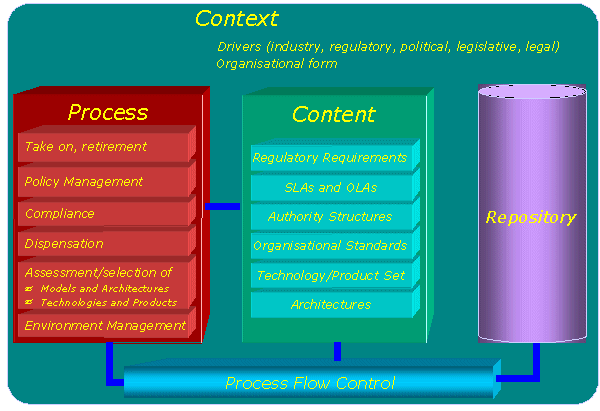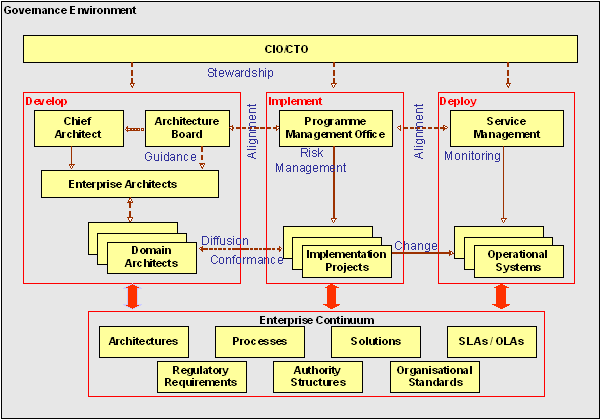Introduction
In the dynamic landscape of enterprise architecture, ensuring the integrity and effectiveness of architectural endeavors is paramount. Enter the Architecture Governance Framework in TOGAF (The Open Group Architecture Framework), a robust set of processes, cultural orientations, and responsibilities designed to oversee and guide architectural initiatives. This article delves into the key components of TOGAF’s Architecture Governance Framework, shedding light on its processes and organizational structure.
Understanding Architecture Governance
At its core, Architecture Governance is a multifaceted concept encompassing processes, cultural aspects, and responsibilities. Its primary aim is to safeguard the integrity and efficacy of the architecture within an organization. TOGAF’s Architecture Governance Framework provides a structured approach to achieving this goal.
A Dual Structure Perspective
1. Conceptual Structure: Nurturing Integrity and Effectiveness
At its conceptual core, Architecture Governance is not just a set of rules but an encompassing approach, a series of interconnected processes, a cultural orientation, and a bundle of owned responsibilities. This conceptual structure is the philosophical foundation that underpins the entire endeavor of ensuring the integrity and effectiveness of an organization’s architectures.
- Approach: It’s not merely a checklist; it’s a strategic approach to how architectural decisions are made, evaluated, and aligned with organizational objectives.
- Processes: Encompassing various processes like Policy Management, Compliance, Dispensation, Monitoring and Reporting, Business Control, and Environment Management, the conceptual structure is a roadmap for navigating the complexities of architectural governance.
- Cultural Orientation: Beyond processes, there’s a cultural aspect—instilling a mindset that values and upholds architectural integrity, making it an integral part of the organizational ethos.
- Owned Responsibilities: Assigning clear ownership of responsibilities ensures accountability, making individuals and teams custodians of the architectural landscape.

2. Implementable Structure: Building the Governance Architecture
To translate the conceptual into the actionable, an effective Architecture Governance structure is imperative. This is the practical, implementable side of the coin—the organizational scaffolding that supports and enforces the principles outlined in the conceptual structure.
- Global Governance Board: Positioned at the apex, this board provides strategic oversight, ensuring alignment with overarching organizational goals and values. It’s the compass guiding architectural decisions on a global scale.
- Local Governance Board: Operating at a more granular level, this board adapts global strategies to local nuances, ensuring that architectural decisions resonate with the specific needs of different business units or regions.
- Design Authorities: These are the experts, the gatekeepers of architectural wisdom. Design Authorities bring specialized knowledge to the table, ensuring that decisions are not just compliant but optimized for success.
- Working Parties: On the ground, working parties bring the vision to life. These are the hands-on teams responsible for executing and monitoring architectural initiatives, turning theoretical governance into tangible reality.

Bridging the Gap: A Unified Architecture Organization
The architecture organization, as depicted in Figure above, forms the bridge between the conceptual and the implementable. It’s the synthesis of philosophy and practice, ensuring that the lofty goals of architectural governance are not lost in translation.
While individual enterprises may have unique requirements, the basic organizational design presented is versatile and can be adapted across a spectrum of organizational types. It serves as a blueprint for creating an architecture governance initiative that is not just effective but sustainable, providing a robust framework for managing and controlling enterprise architectures.
In conclusion, the dual structure perspective of Architecture Governance—conceptual and implementable—provides a comprehensive understanding of its essence and practical application. It’s not just about adhering to rules; it’s about fostering a culture, implementing processes, and establishing structures that collectively shepherd the organization towards architectural excellence.
Key Processes of Architecture Governance
- Policy Management: Integrating Contracts and Governance Content
Policy Management serves as the linchpin, seamlessly integrating architecture contracts with existing governance content. This integration facilitates efficient management and auditing, ensuring that architectural decisions align with organizational policies and objectives.
- Compliance: Assessing Against Standards and Requirements
The Compliance process is a diligent watchdog, performing assessments against Service Level Agreements (SLAs), Operational Level Agreements (OLAs), standards, and regulatory requirements. This ensures that architectural initiatives adhere to predefined benchmarks and industry standards.
- Dispensation: Correcting Non-Compliance
In cases where compliance is not met, the Dispensation process comes into play. It provides the responsible party with an opportunity to rectify non-compliance issues. This step ensures a fair and constructive approach to handling deviations from architectural standards.
- Monitoring and Reporting: Basis of Performance Management
An organization’s ability to adapt and excel relies on effective monitoring and reporting. This process serves as the bedrock for performance management, providing insights into the health and effectiveness of architectural initiatives.
- Business Control: Ensuring Compliance in Policies
Specifically focusing on business policies, the Business Control process ensures that architectural decisions align with broader business objectives. This alignment is crucial for the sustained success of architectural endeavors.
- Environment Management: Repository-Based Efficiency
To maintain an effective and efficient architectural repository, Environment Management comes into play. This process ensures that the repository, which serves as a knowledge base for architectural artifacts, remains organized, accessible, and aligned with the organization’s goals.
Conclusion
TOGAF’s Architecture Governance Framework provides a comprehensive and structured approach to overseeing and enhancing the integrity and effectiveness of enterprise architecture. By integrating key processes and establishing a robust organizational structure, this framework equips organizations with the tools needed to navigate the complex seas of architectural decision-making, ensuring that every wave of change aligns with strategic objectives.